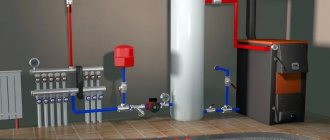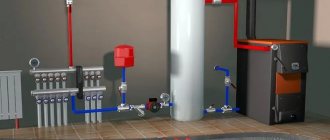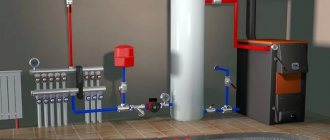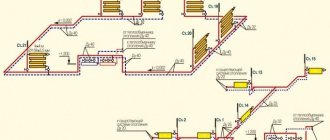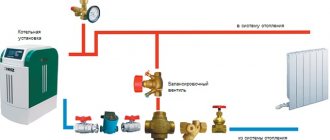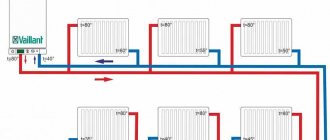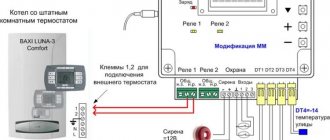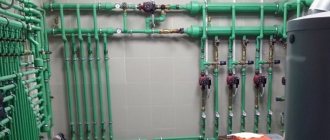Stoves in the house have not lost their relevance to this day; they successfully solve the problem of heating a home. If the house is too large, then using only one furnace device it is difficult to achieve a comfortable temperature in all rooms. In such cases, it is impossible to do without installing an effective heat exchanger and multiple radiators. The coolant is usually water or steam. As a result, the air, walls and floor are heated evenly throughout the building, creating a microclimate quite comfortable for people.
High efficiency of steam heating is possible only if high-quality equipment that meets all standards and requirements is used for its installation. Source plasportal.com
Principle of operation
When installing steam heating in a dacha, a stove or boiler is used as a heat source. With their help, water is heated to boiling point, then the evaporation process begins. The steam penetrates the batteries through the pipeline, gives off heat, and gradually condenses. The resulting water flows into the heat exchanger through the return pipe.
Steam boiler
When choosing a water heater, it is extremely important to pay attention to the performance of the unit. The larger the area of the heated premises, the more powerful the heating device should be.
In houses with steam heating, a solid fuel boiler is often used. A modern gas heat generator is comparatively more efficient. Using an electric device to heat a home is not economically profitable, which is associated with high costs for electricity.
Household steam boilers are used as a heat source for heating a house: they heat a container of water and drive the resulting steam into heating pipes Source eurosantehnik.ru
Bake
If the house has a stove, it can serve as a heat source when installing steam heating. This will save you from additional waste on dismantling the device and repairing the premises. It’s also worth remembering: coal and firewood are inexpensive fuels. When using it, there is no dependence on centralized electricity and gas supplies.
The steam generator is a heat exchanger; you can make it yourself or order it. The design itself is quite simple, consisting of interconnected metal pipes.
If you plan to use a wood stove as a heat source, you should immediately calculate and design a special heat exchanger Source 1-teplodom.ru
Aluminum radiators
This type of radiator can have prefabricated or cast sections. In the first case, each section is pulled together from two parts, in the second it has a one-piece construction.
This type of radiator is lightweight, elegant in design and has excellent heat dissipation, but is very susceptible to the level of acidity in the water supply network and can actively release hydrogen during operation, which leads to air locks. Therefore, this type of radiator must be equipped with an air bleed valve.
Advantages and disadvantages
Equipped steam heating at the dacha has the following advantages:
- provides intensive heating of rooms;
- steam instantly reaches all areas of the heating system, regardless of its complexity or the size of the building;
- pipes never freeze;
- does not require large expenses for the device;
- can be used in buildings for seasonal residence, for heating several floors;
- maximum heat transfer coefficient;
- Can be used together with heated floors.
Flaws:
- circulating along the circuit, steam creates a lot of noise;
- pipes and batteries can heat up above 100°C, which creates a risk of burns upon contact;
- it is difficult to regulate the indoor air temperature;
- the system is susceptible to corrosion, so it does not last very long;
- in the event of a pipeline breakthrough, a dangerous emergency situation is created (the coolant temperature reaches high values).
Important! Steam heating can be used to heat a house with several floors. The steam rises independently to any height, cools, and returns as condensate. Moreover, the installation of expensive pumps is not required at all.
Do-it-yourself heating installation from polypropylene pipes
Polypropylene pipes are connected using threaded or non-threaded fittings. Threaded fittings come in both detachable and non-detachable types.
When installing heating from polypropylene pipes, you must be guided by the following technical conditions:
- polypropylene pipes must be laid away from open sources of fire;
- if there is a need to install a tank or water meter, it is better to use threaded and detachable fittings. One-piece fittings are used only in conjunction with flexible hoses;
- The use of dirty and deformed fittings, as well as independent thread cutting, is not allowed;
- in the case of joining straight sections or connecting polypropylene pipes of different diameters, you need to use couplings;
- in order not to bend the polypropylene pipe at the turning points, during installation you need to use a special square;
- tees are used at branching points.
Having familiarized yourself with the mandatory conditions for the work, you can begin the installation process.
Heating wiring
As we said earlier, for ease of operation, saving time and money, as well as to achieve maximum efficiency of the assembled system, the project must indicate the location of the following elements:
- corners;
- couplings;
- heating equipment;
- fasteners.
The pipeline approaches the batteries from the bottom or side, and is made according to a single- or double-pipe scheme.
Radiator installation
Before connecting the polypropylene pipe to the battery, the battery must first be assembled, equipped with the necessary adjustment elements, and secured to the wall.
The heating radiator is installed as follows:
- We mark the places where the batteries will be installed. According to SNiP, there should be a gap of at least 2 cm between the heating radiator and the wall, and the distance from the radiator to the floor should be 10-15 cm.
- We install brackets for hanging the heating radiator. To do this, you will need a level so that the radiator hangs level, and dowel nails to attach the brackets to the wall.
- Next, the heating radiator is installed on the brackets.
According to this scheme, all batteries are installed in the room.
Connecting batteries
The procedure for connecting a polypropylene heating pipe to a radiator will be as follows:
- We start by attaching the adapter coupling to the radiator. It must be remembered that to connect polypropylene pipes to an aluminum heating radiator, special couplings are used, which differ from those used to connect polypropylene pipes to cast iron radiators.
- We connect a ball valve, radiator valve or control valve to the installed coupling.
- We connect polypropylene pipes to this tap.
- According to the steps described above, the battery output is connected to the heating pipe.
These are the main stages of connecting PP pipes to heating radiators.
Read material on the topic: How to change a heating radiator without errors
Scheme
The heating system operates thanks to natural circulation. Therefore, the heat exchanger must be installed below the level of the radiators. The circulation pump ensures constant operation of the thermal circuit.
There are open and closed steam heating circuits: in the first case, the system is connected to the atmosphere (open), in the second, it is completely isolated from the effects of atmospheric pressure Source s-proms.ru
Steam heating in a house involves the installation of a one- or two-pipe heating system. The optimal choice of the latter depends on the area of the building that is planned to be heated.
Single-pipe
With single-line wiring, radiators are connected in series. The resulting steam passes through a pipeline from one battery to the next. As a result, the first radiator is always the hottest, the last one is almost cold. The single-pipe system is suitable only for small-sized rooms (no more than 80 m²).
Two-pipe
If the house has a huge area, a two-line heating option should be used. A constant supply of hot steam is carried out through the upper pipe. The cooled condensate returns to the heating unit through the lower pipeline. Regardless of the distance from the boiler, all heating batteries heat up evenly.
A single-pipe heating system is more suitable for heating a summer house or a small house; for a spacious cottage or two-story building, it is recommended to use a two-pipe system Source gubernia.media
Preparing to install a steam system
To properly make steam heating, you need to start by preparing the project. Its development is a complex task, which is best solved by specialists. There are many things that need to be taken into account in the finished project.
First of all, the thermal loads on each of the premises and on the building as a whole are calculated. The steam source is selected, and the mechanism and degree of automation of the system are determined.
In addition, the steam consumption must be determined, based on this, the equipment and the scheme for its use are selected. Once the project is ready, you can begin drawing up an installation plan.
To complete it, you will need a building plan on which the equipment locations are marked. They usually start with the boiler. Its location is determined. If the system has natural circulation, the boiler should be below the level of the batteries.
In this case, it is usually lowered into the basement or basement floor, so the condensation can drain to the device on its own. Then the layout of the entire heating system is applied to the house plan. Moreover, all necessary equipment is noted.
Experts advise performing this operation directly “on the spot”, being in the room where the equipment will be located. This is the only way to notice and take into account all the ledges and obstacles that you have to go around.
Before starting installation, be sure to make a plan diagram of the future system, which marks all the equipment and mounting locations for radiators
All transitions and angles must be marked on the diagram. After it is completed, you can proceed to calculating the amount of material required for its implementation. Once again, it is worth paying attention to the importance of choosing the right equipment.
The steam system is potentially hazardous, so you should not skimp on materials and equipment. Everything must be of high quality and certified, otherwise serious problems cannot be avoided.
Materials and equipment
To properly equip steam heating, you need to prepare:
- heat exchanger;
- radiators;
- pipes (preferably galvanized steel, copper);
- pressure reducing valve;
- brackets;
- valves;
- clamps, elbows, fasteners;
- welder;
- hydraulic valve;
- reduction-cooling device;
- pump;
- container for collecting condensed steam.
Advice! To minimize the cost of organizing steam heating, expensive equipment can be rented.
Radiators for steam heating are selected in accordance with the characteristics of the material from which they are made, taking into account the operating temperature Source otoplenieblog.ru
Heat exchanger
When building a brick stove, a heat exchange device will have to be ordered or made on your own. To do this you will need a welding machine and metal pipes. The thickness of the walls of the latter should be more than 2.5 mm. By welding they must be connected in the form of a coil. In addition, it is worth taking care of the tightness of the joints. It is important to take into account that 1 m2 of the surface of a curved spiral produces about 9 kW.
After creating the structure, it is important to check for permeability: fill it with kerosene, then outline the seams with chalk. Darkening of the latter will indicate penetration of a flammable liquid into the heat exchanger. Therefore, it is unacceptable to use such a device for heating with steam.
Self-manufacturing of a heat exchanger is only possible for people who have certain skills, tools and knowledge Source heatylab.com
Installation process
Steam heating in a private house from a stove should be installed in this way:
- When building a stove, place the heat exchanger in the combustion chamber. If the stove device is planned to be used for cooking, there should be no pipes left on top.
- Install radiators and connect the pipeline to them. To ensure natural circulation in the future, it is necessary to maintain a slope (3 mm per 1 m).
- All converters must be equipped with valves designed to remove air.
- For safety reasons, install a shut-off valve in front of each battery or one for the entire system.
- At the beginning of the circuit, install a cooling device, a pressure reducing valve.
- Connect a container to collect condensate. From it, water will flow at an angle back into the heat exchanger. It is not advisable to use a membrane expander: it is not designed for temperatures exceeding 85°C.
- When using forced circulation, install a pump directly in front of the stove (in the return circuit).
Important! Heating systems with natural circulation of steam do not require the installation of a tank or pumping equipment. Therefore, their work does not depend on the presence or absence of electricity.
If heating is planned to be done with solid fuel (for example, wood), then metal pipes must be used to install the system Source 1poteply.ru
Humidity
Hot water radiator
Hot water radiators do not have the added benefit of increasing indoor humidity. However, during the dry winter months, the home often requires additional humidity.
Steam radiator
Steam radiators produce steam, which introduces humidity into the room. The moisture from the steam makes your home more comfortable during the dry winter months.
Best for humidity: Steam radiator. If your home has very dry air during the colder months, keeping steam radiators running for as long as possible can help add moisture to the atmosphere.
Useful tips
When selecting equipment for creating a steam heating system, during its installation it is advisable to take into account the following recommendations:
- You cannot use used heating radiators. They are highly likely to have hidden damage, which will subsequently cause the system to depressurize.
- It is not advisable to use cast iron batteries. Under the influence of large temperature changes, they begin to collapse.
- Installation of the circuit must be carried out by workers with certain knowledge and skills. Otherwise, the created design may be ineffective.
- If you install a steam generator in a conventional wood-burning stove, you can significantly save usable space. In addition, home heating costs will be minimal.
- When using natural circulation, it is recommended to install the stove in the basement of the house. This will ensure that condensation quickly drains to the lowest point.
- For safety reasons and to prevent emergency situations, you cannot refuse to install valves.
The installation of steam boilers in a central heating system is prohibited by law. In private homes, this type of autonomous heating can function for decades without requiring replacement of the main structural elements.
The chimney of a stove with a built-in heat exchanger gets dirty faster than a conventional stove, so it needs to be cleaned more often Source roof-tops.ru
Energy use
Hot water radiator
Water heaters are considered more energy efficient than steam radiators. This is because water heaters move water through the system using a pump, which allows the water to move at a predictable rate.
Steam radiator
Steam radiators are considered less energy efficient than water heaters because they take longer to boil water and release steam.
Best for energy use: hot water radiator. Hot water radiators deliver hot water faster and more predictably than steam radiators. However, both water and steam radiators are considered energy efficient because they can be zoned; Radiators can be switched on and off in separate rooms.
How does steam heating differ from water heating?
In a water heating system, the coolant is often water. It moves inside the pipeline and gradually cools there. In the case of steam heating, the liquid being poured evaporates and hot steam moves through the pipes. After cooling, it condenses and then flows through the return pipeline back to the heating unit.
When the coolant is steam, the thermal output of heating devices is significantly higher, rooms heat up three times faster. Such a system starts up quickly even after a long break in use.
Additionally, it is worth noting the lower cost of materials for steam heating devices. This is explained by the use of compact and ergonomic equipment during installation (for example, pipes of relatively small diameter).
Unlike water heating, steam heating gives greater heat transfer and warms up the room three times faster Source pechiexpert.ru
Calculating the budget
Experts say that such a system costs slightly less than water heating. After familiarizing yourself with the pros and cons of heating private houses with steam, you can determine whether it is suitable for your cottage or country home
Please note that the key to an effective steam heating system is a well-designed design. To calculate it, we recommend that you contact competent specialists to protect yourself and your loved ones.
We hope that the information provided in this article will be useful to you, and you will be able to use steam heating, assembled with your own hands.
Control.
The control system of a steam boiler includes devices for turning fuel combustion on and off, setting and regulating fuel, air and water flow rates, for collecting and processing feedback data from turbines and devices that control boiler performance. In the past, many of these functions were performed manually. Later, electronic circuits were used to implement some of them, first on electric vacuum and then on semiconductor devices. Modern computer technology has revolutionized the control of steam boilers, as well as many other systems. see also
INTEGRATED CIRCUIT; TRANSISTOR.
CLAIM
1. A single-pipe heat supply system with regulation of coolant flow, containing a set of heat exchangers (6) connected in series, so that the return pipeline of one heat exchanger (6) is the supply pipeline of the next heat exchanger (6); main supply pipeline (1), connected to the supply pipeline (3) of the first, when viewed in the direction of flow, from the heat exchangers (6); main return pipeline (2), connected to the return pipeline (4) of the last, when viewed in the direction of flow , from heat exchangers (6); in which the coolant with a supply temperature is supplied at a certain flow rate from the main supply pipeline (1) to a set of heat exchangers (6); moreover, this system additionally contains a flow regulator (9) connected to the return pipeline (4) , where the flow regulator (9) is designed to regulate the flow rate in the return pipeline (4); an actuator (10) that controls the flow regulator (9); temperature sensor (11), which is in a state of heat exchange with the coolant in the return pipeline (4).
2. A single-pipe heat supply system according to claim 1, in which the flow regulator (9) is additionally designed to maintain a constant flow rate, despite changes in pressure in the main supply pipeline (1).
3. Single-pipe heating system according to claim 1 or 2, in which an external temperature sensor (8) is installed to measure the temperature external to the system.
4. One-pipe heat supply system according to claim 3, in which there is an electronic regulator (18) connected to each actuator (10), and temperature sensors (11) are connected to the return pipelines (4) of the system.
5. One-pipe heat supply system according to claim 4, in which the electronic controller (18) is connected to a temperature sensor (19) connected to the main supply pipeline (1).
6. One-pipe heating system according to claim 4 or 5, in which the electronic controller (18) is connected to the outside temperature sensor (8).
7. Single-pipe heating system according to any one of claims 4 or 5, in which each actuator (10) is driven by pulses.
8. Single-pipe heat supply system according to claim 7, in which each actuator (10) is an electromagnetic, pneumatic, hydraulic or electrostrictive actuator.
9. Single-pipe heating system according to any one of claims 4, 5 or 8, in which the electronic controller (18) is configured to monitor the measured parameters and use this data to optimize the supply temperature setpoint depending on the outside temperature and the return temperature setpoint in depending on the flow temperature setpoint.
10. The one-pipe heat supply system according to any one of claims 1 or 2, in which each actuator (10) is connected directly to a temperature sensor (11), is an autonomous device and contains means for regulating the temperature setpoint in the return pipeline.
11. Single-pipe heat supply system according to claim 10, in which the actuator (10) is a thermostat.
12. Single-pipe heat supply system according to any one of claims 1, 2, 4, 5, 8 or 11, in which the supply pipeline (3) and return pipeline (4) of each heat exchanger (6) from the set of heat exchangers (6) are additionally connected bypass (5).
13. A single-pipe heat supply system according to any one of claims 1, 2, 4, 5, 8 or 11, containing at least two sets of heat exchangers (6) connected in series with each other and connected to the same main supply pipeline ( 1) and the main return pipeline (2) with separate flow control in each of the sets.
14. Single-pipe heat supply system according to any one of claims 1, 2, 4, 5, 8 or 11, in which the supply temperature is controlled in accordance with the temperature setpoint in the supply pipeline depending on parameters external to the system, and the flow rate is controlled in accordance with with a temperature setting in the return pipeline depending on the temperature of the coolant downstream from the first device (6) of the set of heat exchangers.
15. The single-pipe heating system of claim 14, wherein the return temperature set point is adjusted in response to the supply temperature set point being adjusted.
conclusions
In general, hot water radiators are more common in new homes and are more efficient and easier to maintain than steam radiators. However, one of the reasons why the use of both water and steam radiators is being phased out is the possibility of leakage. No matter how much effort you put into maintaining a centralized radiator system, a leak will occur at some point. It's also important to keep in mind that while blower pipes can act as heaters in rooms, they also waste energy when they pass through other areas of the home, such as between the floor and ceiling.
URL: thespruce.com/hot-water-vs-steam-radiators-1821916
Fire tube boiler design
A simple operating principle determines the design. The body shape can be varied, but the most common is the cylinder shape. On one side there is a combustion chamber, and on the other side there is a smoke removal system. Combustion is supported by a forced blowing device.
Above the firebox there are heat exchangers that are in contact with the smoke exhaust duct. For increased heating efficiency, the heat exchanger is made of small cross-section pipes. The most common are three-pass fire-tube boilers. Its main difference from the conventional design is the presence of three smoke exhaust channels.
The first channel is considered to be the firebox, and the other two are located above one another. The fan provides the necessary draft, and there is also natural draft through the grates and ventilation holes.
In addition to the specified parts, the installations are equipped with the following components to improve their characteristics:
- air outlet channels;
- steam pressure gauge;
- coolant thermometer;
- control unit;
- pressure controllers;
- emergency protection.
